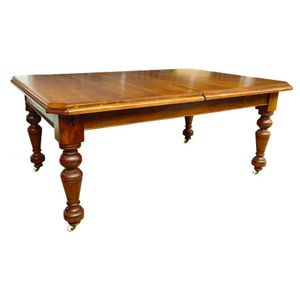Rare Colonial Jarrah Dining Table, c.1870-1880
You must be a subscriber, and be logged in to view price and dealer details.
Subscribe Now to view actual auction price for this item
When you subscribe, you have the option of setting the currency in which to display prices to $Au, $US, $NZ or Stg.
- Turning - Any part of a piece of furniture that has been turned and shaped with chisels on a lathe. Turned sections include legs, columns, feet, finials, pedestals, stretchers, spindles etc. There have been many varieties and fashions over the centuries: baluster, melon, barley-sugar, bobbin, cotton-reel, rope-twist, and so on. Split turning implies a turned section that has been cut in half lengthwise and applied to a cabinet front as a false decorative support.
- Jarrah - A eucalypt, known by its aboriginal name jarrah, it grows only in the south-west of Western Australia. The timber is a dark red-brown in colour with similar grain and colouring to mahogany and was used extensively in house construction as well as for making furniture.
- Victorian Period - The Victorian period of furniture and decorative arts design covers the reign of Queen Victoria from 1837 to 1901. There was not one dominant style of furniture in the Victorian period. Designers used and modified many historical styles such as Gothic, Tudor, Elizabethan, English Rococo, Neoclassical and others, although use of some styles, such as English Rococo and Gothic tended to dominate the furniture manufacture of the period.
The Victorian period was preceded by the Regency and William IV periods, and followed by the Edwardian period, named for Edward VII (1841 ? 1910) who was King of the United Kingdom and the British Dominions and Emperor of India for the brief period from 1901 until his death in 1910. - Castors - Wheels, fitted especially to chair legs, couches, tables and some smaller pieces of furniture, to enable them to be easily moved about. The earliest castors were of brass, with shanks fitting into the base of the leg, and the wheels often made of leather. In the late 18th century, brass 'bucket' or 'cup' castors were introduced, either rounded or square, fitting directly over the end of the leg and held in place with screws. The wheels were generally solid brass. Bucket/cup castors continued in use throughout the 19th century and indeed are still made today. In the later 19th century wheels were sometimes made of wood, china, either white or brown, and sometimes of steel.
- Provenance - A term used to describe the provable history of an antique or work of art, and thus an additional aid to verifying its authenticity. Provenance can have an inflating effect on the price of an item, particularly if the provenance relates to the early settlement of Australia, a famous person, or royalty. Less significant are previous sales of the item through an auction house or dealer.
This item has been included into following indexes:
Visually similar items

A colonial kauri banquet extension dining table, the plank top with heavy moulded edge, extending to receive two leaves and seat 12, raised on baluster turned legs with brass and white porcelain casters. 271 x 124.5 x 76.5 cm

A Victorian two leaf extension dining table c.1850's, the table has a winding mechanical type action which extends for one or two leaves the legs are bulbous and reeded style with porcelain castors. Height 74 cm. Width 115 cm. Length 235 cm

Victorian walnut extension dining table with canted corners on baluster ringed legs with three additional leaves seating twelve

A square walnut centred table, Italian 18th/19th century. 84 cm high, 103 cm wide, 103 cm deep
